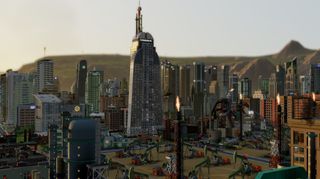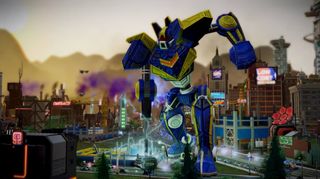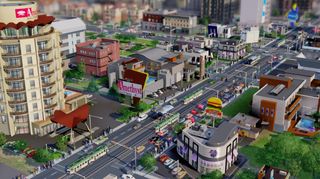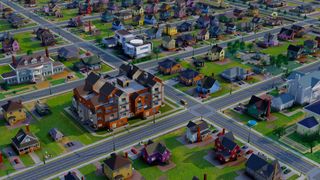SimCity launched a decade ago, and it was so disastrous it killed the series
The launch of SimCity 2013 was cataclysmic, but it never really stood a chance.

"It was heartbreaking," says SimCity lead designer Stone Librande. "Coming into the office the next day, I remember EA had para-trooped the server IT people in, and it was just noise and new people and everybody scrambling. Alarm bells were going off, and it was like, 'Oh, what is going on?'"
For Librande and his team, the worst outcome to years of work was unravelling before them. The game they had dedicated so much time to was in freefall, and any chance of recovering from the damage looked slim. Players were angry, developers were frustrated, and executives were disappointed. It was 2013, and SimCity had collapsed.

Four years earlier, developer Maxis had set out to create the next instalment in the beloved city-building series. It had just finished up with alien simulator Spore to mixed reception, leaving studio veterans Ocean Quigley and Andrew Willmot time to tinker around on a side project. Inspired by the malleability of The Sims—another massive Maxis series—and its scope for player choice, they wanted to try their hand at building a new type of simulation engine. They started work on what was essentially a tech demo, but one they hoped would offer even more granularity than the sims the studio had a reputation for.
"We weren't sure what we were going to do with it, at all," says Quigley. "It was just an R&D project—one engineer, one artist—and so it was cheap for EA to prototype." It showed promise and executives at the publisher spied an opportunity. The isometric camera and rudimentary visuals of SimCity 4 were beginning to look dated next to the biggest triple-A games of the day, and the multi-million dollar series hadn't received a sequel in several years. EA was looking to justify the time and money it had already spent on Quigley and Willmot's experiment, and transforming it into a follow-up to one of its more successful franchises seemed like a bankable win.
EA gave the green light for the duo to explore whether their new simulation tech could be scaled up to the size of a full game, and Librande soon joined them as a designer, with Quigley leading art and aesthetic direction, Willmot on back-end architecture, and a handful of others filling in the gaps. After a further six-month prototyping phase, development began in earnest, and ambitions for what had by that point morphed into the next mainline SimCity were set high.

"We wanted to make it more dynamic," says Quigley, who hoped the new engine would more responsively visualize the interactions of the city's inhabitants. Unlike past games in the series, this SimCity would model the behaviour of individual people, cars and businesses to more organically and realistically replicate city life. "I had a sign above my desk that said 'Cities are people, not buildings,'" says Librande. "That was an urban planning quote. You don't want to think of a city as a collection of buildings and streets. You want to think of it as humans moving through these systems, from place to place."
It was definitely like we needed to do it because at that time every game had multiplayer components, or was expected to have multiplayer.
Stone Librande, lead designer
As the project ramped up and more developers joined, EA largely took a back seat. Although it did make one request: SimCity should step outside the single-player bubble and embrace the fad of the moment—multiplayer.
The biggest gaming news, reviews and hardware deals
Keep up to date with the most important stories and the best deals, as picked by the PC Gamer team.
"It was definitely like we needed to do it because at that time every game had multiplayer components, or was expected to have multiplayer," says Librande. But he recalls the team at Maxis was largely on board with the idea. The thought of having players team up to construct cities in neighbouring regions, and interact with one another by trading resources, sharing services, or polluting the common environment, seemed like a natural step towards further realism.

"My personal goal, because I have two sons, was I wanted to be able to play with my family," says Librande. "I wanted to be able to set up, with my friends, a little region and work together or sometimes compete with each other; make a whole bunch of crime and export it into their city to mess it up. All of that emergent storytelling that comes out of people working together or not working together are stories about real cities, too."
Multiplayer soon became one of the game's headlining features, as well as a main selling point in the marketing leading up to its launch. Nestled between Dead Space 3 and FIFA 14, SimCity was placed in prime position to fill a slump in EA's calendar. By early 2013, it had been over a decade since SimCity 4 launched, and droves of fans eagerly pre-ordered what promised to be an ambitious revitalization of the series. That, unfortunately, turned out to be the problem.
Struck down
When SimCity launched on March 6, it required players to maintain an active online connection to the game's servers. If that connection dropped, they'd be booted from the game. The problem, simple as it seemed, was significant: there wasn't enough server space to go round. Players were met with frequent crashes, extreme latency, exceedingly long load times, disconnections, and delayed downloads. Swathes were unable to get into the game at all, left endlessly hanging in the launch menu, let alone experience the fresh multiplayer city building they were promised. The game's servers buckled under the tidal wave of players trying to connect, and there was no subsidence on the horizon.

"In the development process, we brought in beta testers, and the infrastructure was fine for a small group," says Quigley. "Everything was snappy and tight, and that gave the EA brass a false sense of security about how much infrastructure they would need… Setting aside whether it was a bad idea to make it online-only in the first place from a gameplay and aesthetic perspective, the really inexcusable part was, even given all those decisions, the server infrastructure was a factor of 10 off what it needed to be in order to give people a satisfying experience."
Everything was snappy and tight, and that gave the EA brass a false sense of security about how much infrastructure they would need.
Ocean Quigley, creative director
Unable to play the game, players didn't hold back in their criticism, and neither did the press. Initially high review scores were drastically downgraded, and Maxis spent the next week scrambling to expand server capacity. "We feel bad about what happened," general manager Lucy Bradshaw said in something of mea culpa shortly after launch. "We're hoping you won't stay mad and that we'll be friends again when SimCity is running at 100 percent," adding that EA would be offering disgruntled players their pick of a free game as compensation.
While fans were angry, feelings inside Maxis weren't much rosier. EA had sent additional technicians to the studio to bolster the servers it had woefully overestimated, but it didn't have the infrastructure to respond at speed. Work was necessarily slow-moving and frustratingly laborious. "Every time they would unblock one pinch point, then they would just discover the next one," says Librande. "You were unblocking the dam and then the flood goes and hits the next dam. Then everybody scrambles, tears that one apart, ok, but it keeps going".

As capacity gradually improved over the next couple of weeks, EA stuck to its guns. Bradshaw released another statement to ease fan backlash, this time justifying the alway-online connection requirement that had prevented so many from playing. She framed it as a necessary caveat of SimCity's real-time multiplayer experience, although that didn't quite tell the full story. "SimCity was one of the most pirated [series] of all time and so there was a directive to find: 'How can we make this un-piratable,'" says Librande. "One of the ways to do that is to keep a lot of the data on the server so that there's nothing to really hack, and if you do hack your own copy of it, then you still have to be validated by the servers."
EA had experimented with anti-piracy systems using Maxis's games in the past, releasing Spore with a strict DRM policy that limited the number of computers on which a disc copy could be installed. But with SimCity, the publisher had its sights set on an even bigger cash cow beyond individual unit sales. EA had released digital storefront Origin two years earlier, and was looking to drive users to the platform in the hope of turning it into a serious competitor to Steam. Just as Valve initially encouraged take-up of its platform by requiring its installation to play Half-Life 2, EA wanted to pull a similar trick with SimCity.
"From EA's perspective, Origin was much more important than SimCity," says Quigley. "Origin is the storefront in consumers' machines, so the motivation was to make SimCity online and use it to push Origin." By removing as many possible barriers between consumers and the storefront, EA hoped players would gradually migrate over, navigating through the store and its many dollar signs every time they went to boot up the game. "Maybe it would have worked," says Quigley, "if the infrastructure was in place."
Abandon city

SimCity had stumbled out of the gate and its future didn't look bright. Before launch, Librande had started leading development on its first expansion pack, Cities of Tomorrow, and recalls worrying whether the add-on would ever be released. As teams of server technicians continued to doggedly bring the base game into shape, its longevity was quickly called into question. "The model was going to be a kind of live service," says Librande. "We would keep making expansion packs very much like The Sims, and were just going to add in these things over time. There was always this sense like [once it was] out there, it was just going to get better and better."
It didn't pan out that way. EA and Maxis stabilized SimCity's servers in the following weeks through persistent maintenance and months later successfully shipped the expansion. But rather than marking the beginning of a long, fruitful development period in which SimCity's content would be expanded upon, it rang the game's death knell. Plans for future expansions were dropped, and EA moved on to its next project for the series: a mobile SimCity spin-off that it hoped it could develop more quickly and at a much higher profit margin.
"They were using a lot of the assets that we had created for SimCity 2013," says Librande, "so they were able to gather a mobile SimCity fairly quickly from the four years of work that we had invested." The spin-off was released in late 2014 as SimCity BuildIt. A free-to-play construction game packed with microtransactions, it's still updated today and remains the latest release in the franchise—not that Maxis has anything to do with it. After Quigley and Librande left the studio in the months following SimCity's release, EA closed the principal Maxis studio in March 2015, almost exactly two years after the game's disastrous launch.

That same month, any chance of a late revival for SimCity all but vanished, as it was comfortably surpassed as the medium's foremost urban simulator. Cities: Skylines had appeared, bearing many of the same design principles, visual stylings, and UI motifs. It was met with rave reviews, as well as an audience that was hungry for a new title to fill the space left by Maxis's now-infamous ill-fated game. "I was thrilled to see Cities: Skylines pick up the mantle because EA pretty much said, 'We're done with this for now,'" says Quigley. "So if it wasn't Cities: Skylines doing something ambitious with it, then these ideas were just going to fall by the wayside and never really go anywhere."
I was thrilled to see Cities: Skylines pick up the mantle because EA pretty much said, 'We're done with this for now'.
Ocean Quigley, creative director
A decade on, both designers say they have fond memories of SimCity despite its troubled launch. For Librande, it remains his favourite project he's worked on in his 20 years in games. It was an ambitious step forward for the series that boldly experimented with new ideas, even if it never did quite live up to its promise—or was never given the chance.

"The game shipped too early; I'll blame that on EA corporate," he says. "We had already gotten a lot of extensions. We had already begged and pleaded to have more time, and at some point, as a public company, they have certain obligations to their shareholders. One of them was that SimCity would be shipping that quarter."
Quigley has similarly bittersweet feelings. For all its novel ideas and aesthetic vision, he says, SimCity was never going to fly smoothly while its servers were so drastically unfit for use.
"It was really a pretty wonderful project to work on. We created a deep, engaging simulation that admittedly could have used another six months of iteration and polish. But most people didn't get to experience that. Most people experienced nothing but lockouts."
Most Popular


